
| Go to Allan's Page | 2019 Part 1: via Stratford and Gloucester | Canals Home Page | 2019 Part 3, Liverpool itself and our return | Go to Deb's Page |
We had successfully reached Gloucester, despite various closures and obstructions, and now we could spend a few days travelling the length of the beautiful Gloucester & Sharpness Canal. We love this canal, with its wonderful views across the River Severn as well as its spectacular bridge-keeper's houses and the variety of watercraft to be found there.
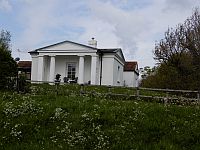 |
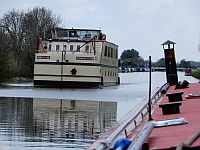 |
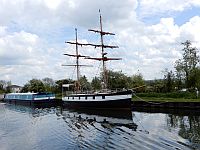 |
A bridge-keeper's cottage |
We met the hotel-boat Edward Elgar |
I would love to go sailing in this one! |
The weather alternated between beautiful sunshine (in which we travelled) and torrential rain (in which we didn't), and we started to plan the next stage of our journey towards Liverpool, as we had booked specific dates for our stay there. Two things concerned us slightly: firstly, the Severn was running rather fast (and was likely to rise even further when the rain that had been falling in Wales travelled down to us) and secondly, there had been a landslip near Kidderminster which had closed the Staffs & Worcester Canal so that we may be delayed or diverted. These two factors convinced us that we should pass straight through Gloucester and get back up-river as quickly as we could. The river was about 4ft above its normal level below Gloucester Lock, so we had a long slow trip up to Chaceley again and were relieved to find that the moorings at the Yew Tree Inn were again available for us to have another superb dinner and to stop overnight. After that we pushed on upstream, against the strong current, to stop overnight firstly again at Worcester and then at the re-opened and newly-refurbished Hampstall Inn where, as always, we received a friendly welcome and had an excellent meal to mark our last night on the River Severn.
We wondered if we would have to go back down the river and join the Worcester & Birmingham Canal to by-pass the stoppage on the Staffs & Worcester, but we received an email from CRT that their engineers had managed to open a narrow channel through the landslip so that boats could squeeze past under supervision. In fact by the time that we got there CRT had decided that boats could pass unsupervised, as long as they did so during normal working hours and could therefore call for assistance if there was a problem.
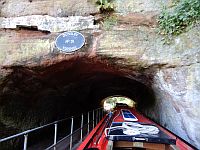 |
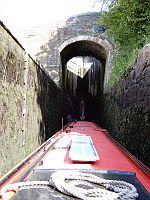 |
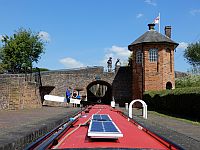 |
This short hand-cut tunnel has a fascinating charm all of its own |
The view from the bottom of Botterham staircase locks is rather impressive |
The unique flight of locks at Bratch |
In good weather we were now making excellent progress as we headed up first the Staffs & Worcester Canal and then the Shropshire Union, and had plenty of time for a brief diversion up to Llangollen. We were uncertain whether or not we would be able to pass through Hurleston Locks because one of them has narrowed considerably due to land slippage; repairs had been scheduled during the winter but the scale of the work required had proved to be so much that the work had been postponed for a year. Apparently the chamber was becoming measurably narrower every week, and several boats had become stuck in recent weeks. Our own boat has also spread slightly with being over-plated; however with the help of two CRT staff we just managed to squeeze through (and back again the following week, phew!)
Our good progress continued up the Llangollen Canal until Grindley Brook where we encountered a chaotic scene; there seemed to be boats all over the place! Boats were queuing in both directions at each of the single locks, but nobody was willing to help anybody else so no boats were moving anywhere. Debbie and I sorted out the mess, even persuading some of the crews to open a gate or a paddle for each other, and soon we were ascending the staircase and chatting to the friendly, helpful lock-keeper. However our progress from then onwards was very much slower, as the long pound was extremely short of water and was at least 8" down from its normal level. On many canals this would not make a great deal of difference, but the Llangollen Canal is so shallow that navigation is extremely tricky when the water-level is low; many of the boats we encountered were clearly being steered by people who were unaccustomed to dealing with shallow waters, and we frequently had to stop and wait while they got themselves clear of the shallow edges (or, on several occasions, while they got themselves more and more firmly stuck).
The pre-booked date of our visit to Liverpool was approaching rapidly, so after a couple of days in Llangollen we had to hurry back down the canal to Barbridge, where at the Olde Barbridge Inn we were 'persuaded' to discover the delights of yet another gin - Sicilian Blood-Orange - which we loved so much that we just had to buy a bottle to take away!
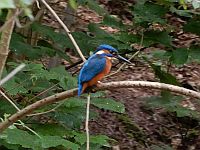 |
 |
It wasn't easy steering through a cutting and taking a photo of this beautiful kingfisher |
It was much easier taking a photo of this beautiful sunset (neither the boat nor the sun were moving) |
This year we were able to use the Middlewich Branch, which had been closed by an embankment breach last year. The 'official' version of how that breach had occurred seemed to be somewhat at odds with reports from people who were present at the time, and now the 'official' statement that the repair had been satisfactorily completed seemed rather at odds with statements from local residents who refer to the aqueduct there as the local car-wash because it leaks so much. I must say we were quite relieved to get past the site of the breach and continue our journey northwards without delay.
We continued on to the Bridgewater Canal, and crossed the Barton Swing Aqueduct. As we did so, I wondered how a horse would have crossed the aqueduct in the days of horse-drawn boats. Puzzled, I asked the question on the Canal World Forum, and was interested to find out that there had originally been a towpath high above the canal, at the level of the bridge that crosses the canal before the start of the aqueduct. It had been supported on metal brackets, the remains of which can still be seen along the edges of the aqueduct if you look hard; I cannot imagine how they persuaded the horses to walk along it!
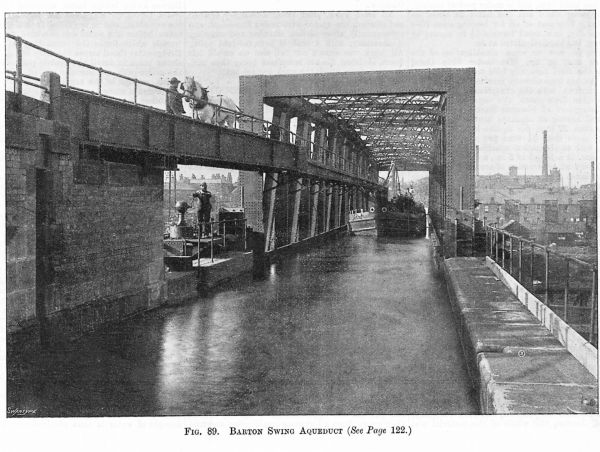
Ten years ago, in 2009, we were lucky enough to be able to watch as the aqueduct, with its 800 tons of water, swung smoothly on its 120-year old mechanism. I was able to video the event then, and here it is at double speed to make it more watchable. Note that the gates are still worked manually despite the automation of the main mechanism.
The Bridgewater Canal is, of course, not owned by CRT. We had feared that we might need to buy an additional licence for it, but the Bridgewater Canal Company were very helpful when we told them of our plans to travel to Liverpool and back; they agreed that as long as we stuck to our stated plans we would not need an additional licence. Of course, travel plans on the canal tend to be rather variable, and already we had had to change our plans because a swing-bridge near Liverpool had been vandalised and would only be passable for one hour on each of two specified days per week.
At the northern end of the Bridgewater Canal we rejoined CRT waters on the Leeds & Liverpool Canal. Most of this beautiful canal is inaccessible to us because our boat is too long to fit into the locks, so we have not travelled its length since 1990 when we crossed its spectacular summit from Leeds to Wigan in our previous boat Thistle. However the western end of the canal has full-length locks which can accommodate us easily (with 3ft to spare). Soon we were at Wigan, and for the first time ever we pointed our bows westwards towards Liverpool ...
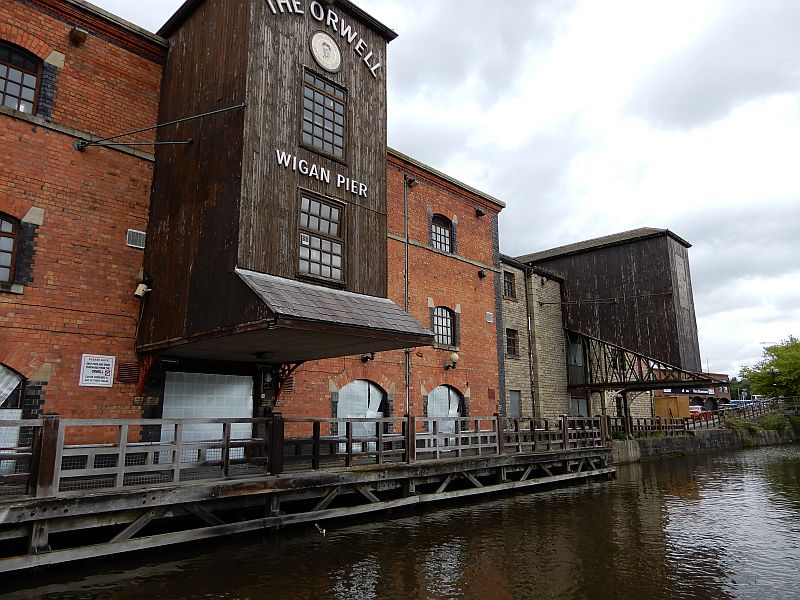
At Wigan Pier
| Go to Allan's Page | 2019 Part 1: via Stratford and Gloucester | Canals Home Page | 2019 Part 3, Liverpool itself and our return | Go to Deb's Page |
All pictures on this site are © Allan Jones unless otherwise stated